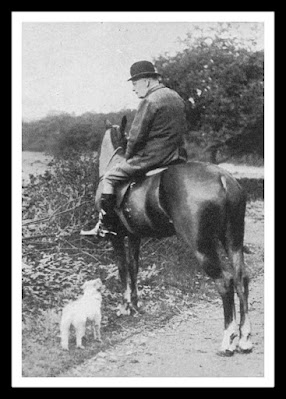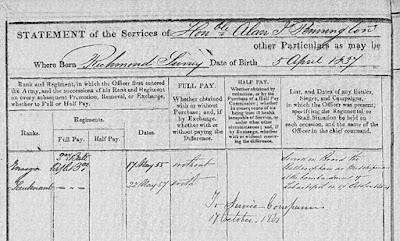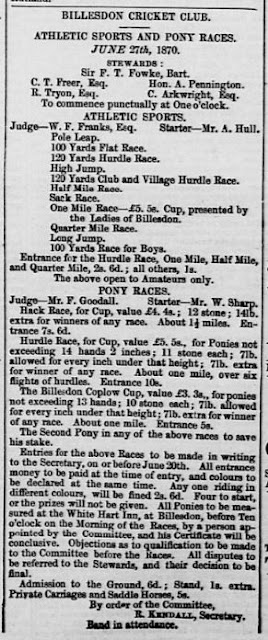You may recall I visited Blenheim Palace way back in 2019, when I rather embarrassed myself by exclaiming loudly when I came across a mention of Baron Muncaster? No? Well, not to worry, as this post will explain the connection with Loughborough!
Alan Joseph Pennington was born on 5th April 1837 in Richmond. He was the 6th of 7 children born to Lowther Augustus John Pennington, 3rd Baron Muncaster, and his wife, Frances Catherine (nee Ramsden). Sadly, two of their children died at birth – Josslyn, born and died on 24 August 1833, and in March 1836, Rachel Matilda Pennington was born and died.
 |
| Alan Pennington in later life |
Alan’s older siblings were Fanny Caroline, who was born on 26 August 1829, less than a year after Lowther Augustus John Pennington had married Frances Catherine Ramsden (3 June 1806- 1853), the daughter of Sir John Ramsden, who was the 4th baronet of Byram, near Pontefract. Lowther had acceded to the title Baron Muncaster in 1818 upon the death of his father, the second baron. Lowther and Frances Catherine married at St Edward the Confessor church in Brotherton.
 |
| Marriage record for Lowther and Frances Catherine, 1828 |
The next child to be born to them was Gamel Augustus Pennington, who was baptised on 31st July 1832 in Muncaster, Cumberland, followed by another boy whom they named Rosslyn, on 25th December 1834, who was baptised on 17th June 1835. Following Alan Joseph’s birth in 1837, there came the youngest child, Louisa Theodosia Pennington baptised on 17th July 1838, just over two months after the death of her father at the Green Park Hotel, Piccadilly. The title of Baron Muncaster passed to Gamel, who at the time of his father’s death was only aged seven.
After the death of their father, the Pennington children accompanied their widowed mother to church twice every Sunday, and although they were allowed to play games and go for walks afterwards, Sundays were always quiet days. As expected of the aristocracy, the boys – Gamel, Josslyn, and Alan – were educated, firstly at a preparatory school in Hatfield, run by clergyman the Rev. Francis J. Faithfull, and then attended Eton College. [1] Completion of education at Eton leads to attendance at another school with the purpose of ‘cramming’ to ensure acceptance into Cambridge University. Certainly, this was the case with Gamel, who attended another school at Harrowden in 1850, which was run by clergyman Mr Roughton, where he learned drawing, more classics, and modern history, before entering Trinity College Cambridge at Michaelmas term. Josslyn, too, attended a cramming school in 1852, at Reading, but he was studying for the army entrance exams, six months later being commissioned into the 90th Light Infantry Regiment, at which time he was about 18 years old.
Around this time – 1853 – Frances Catherine Pennington, living at Warter Hall in Yorkshire, mother to Fanny, Gamel, Josslyn, Alan, and Louisa, died. Her eldest son, Gamel, had only recently reached the age of majority (i.e. 21), and had just graduated from Cambridge University.
What of Alan? Well, having completed his education at the Hatfield school under the Rev. Francis J. Faithfull, he joined the Royal Navy as a midshipman, at the age of only 14. On 17th October 1854, Alan was involved in the bombardment of Sebastopol. He served on the HMS Bellerophon [2], and gained a Crimean medal and a clasp for Sebastopol and the Turkish medal. Brother, Josslyn, also fought in the Crimean War, notably in the Battle of the Great Redan, on 18th June and 8th September 1855, and at one time, Josslyn was Captain of the 11th Pocklington Company of the 1st Administrative Battalion of the East Yorkshire Volunteers.
 |
| Part of Alan Pennington's Navy record |
Just before the Battle of the Great Redan, on 17th May 1855 Alan had transferred from the Navy to the Rifle Brigade, under the influence of Sir Charles Grey, private secretary to Prince Albert, who approved of the move. He began as what was known at the time as an ensign, but since 1871 would be known as a 2nd Lieutenant.
Meanwhile, on 2nd August 1855, Josslyn and Alan’s older brother, Gamel, the 4th Baron Muncaster, married the young Jane Louisa Octavia Grosvenor, the daughter of the Marquis of Westminster, in St George’s church, Hanover Square, London.
Two years after his transfer from the army to the Rifle Brigade, on 22 May 1857 Alan was promoted to Lieutenant. In November 1858 his younger sister, Louisa Theodosia married Mr Edgar Atheling Drummond, in Piccadilly. Gamel, the 4th Baron, becomes Deputy Lieutenant of the County of East Riding, and Cumberland, and High Sheriff of Cumberland, and Josslyn is initiated into the Freemasons, Lodge of Malta, in 1859, and retires from the army in 1860.
Sadly, in June 1862, Gamel Augustus Pennington dies, and it is widely reported his death was caused by gastric fever. He and his wife had been abroad since the beginning of the year, in the hope of improving Gamel’s health, hence he died in Castellamare, near Naples, but is buried at Muncaster. Gamel’s older sister, Fanny, had a stained glass window designed by Charles Alexander Gibbs, and dedicated it to her brother Gamel after his death: this window is in St James church, in Warter, where the family had a home.
Upon the death of Gamel, the title then passed to his younger brother, Josslyn Francis Pennington, who became the 5th Baron Muncaster. The following year, Josslyn married Miss Constance L’Estrange, a niece of the Earl of Scarborough, and a cousin of the Gore-Booth family of Lissadell, County Sligo in Ireland.
From what we have learned so far, the Pennington estates were divided across England: the family seat was at Muncaster Castle, in Ravenglass, Cumberland, and Josslyn, the second son, first inherited an estate near Pocklington, York, which I believe is Warter, although he sold this off in 1878. The family also rented a house in Chelsea, London each year. The Ramsdens, who were cousins of the Penningtons, also had estates in Yorkshire – at Huddersfield and a seat at Bryam near Ferrybridge. Other cousins of the Penningtons were Scots, the Earls of Crawfurd and Balcarres and their families. The Penningtons were primarily Cumbrian, but also had strong Yorkshire roots, and close Irish and Scottish connections. Nothing remotely connected with Leicestershire … yet …
On 23rd March 1863, having completed 8 years’ service with the Rifle Brigade, Alan Pennington retires, and appears to move from the Richmond Barracks where he was posted, to Langham, in Rutland, where he appears in directories and electoral registers as having a house and land on Melton Road. On 12th July 1864, Alan’s older sister, Fanny Caroline, died in Switzerland, but I have been unable to establish why she was there, and what the cause of death was. She was said to have been of 41 Clarges Street, Piccadilly, and her will was proved by her brothers, Josslyn and Alan, the amount being under £25,000. She bequeathed to her sister, Louisa Drummond, all her jewels, with the exception of a pearl necklace, bracelet and earrings, and diamond star, which she left to her brothers. Josslyn was of Warter Priory, and Alan was listed as of 41 Clarges Street, so the same address as his sister. [3]
By 1868, Alan had moved to White Hall in Billesdon, from what I gather was a prestigious area for fox-hunting, a popular pastime for the aristocracy (remember, we’re talking mid-late 1800s here, and views on fox-hunting were quite different from those held today). Alan appears to have lived in Billesdon for about 10 years, and during that time hunted with Mr Tailby’s hounds.
 |
| White Hall, Billesdon, August 2023 |
We’ll come back to Alan’s life in a moment, but let’s go back and see what’s happening with his brother, Josslyn. In 1870, while travelling in Greece with a group of friends, the Lord Muncaster (Alan Pennington’s older brother, Josslyn) and his travelling companions were captured by brigands, although the women in the party were released very quickly. The brigands sent Lord Muncaster off to arrange for a ransom to be paid for the release of his companions, but this was unsuccessful and Mr Herbert (a relative of the Earl of Carnarvon), Mr Vyner (related by marriage to the Marquis of Ripon), and an Italian count were murdered by the gang. During the capture, Alan was dissuaded from going to Athens to help, but corresponded with his brother. Josslyn is said to have taken this all very badly (not surprising really), and eventually his letters from the time were reproduced in a book, which helps to tell his side of the story. Contemporary newspapers across the globe covered the story, and eventually the survivors made it home.
 |
| Report from The Constitution: Or, Cork Advertiser 18 April 1870 |
Having not gone to Greece to help his brother, Alan remained in Billesdon where he was a steward at the amateur athletic sports events in 1870 and 1871, and he was pleased to receive from Frank Goodall, [4] a signed copy of ‘The Science of Foxhunting’ (1868) by Knightley William Horlocks, whose used the pen name Scrutator.
 |
| Advert from the Leicester Journal, 3 June 1870, pg 4 |
On the 1871 census return, Alan Pennington, now aged 33, is living in Billesdon, where he has three domestic servants, Elizabeth Birch aged 44; Elizabeth Boxall aged 17, and James Boulger, aged 17.
Having safely returned to the country, in 1872, Josslyn becomes MP for West Cumberland, while Alan continues with his ‘sport’, being reported as being highly thought of by Mr Tailby; being described in ‘The Field’ as a conspicuous aristocrat at the Billesdon Hunt, and in the ‘Leicester Journal’ as “a model light weight, and his riding is good as good can be”.
In 1876, Josslyn became the Lord Lieutenant of Cumberland, and in 1877, Alan took on the mastership of the Holderness Hunt, in East Yorkshire, succeeding Mr James Hall, who had been land agent to Lord Hotham. [5] The Committee of Management of the Holderness Foxhounds, suggested that Alan’s “long residenc[y] in Leicestershire, and great experience [would] eminently fit him as a successor of so true a sportsman as the country has just lost.” – ‘Yorkshire Gazette’ August 18, 1877. Writing in 1878, J. Nevill Fitt suggested the Hon. Alan Pennington, was a very promising master, who was “for many years very well known in Mr Tailby’s country and the Pytchley, not only as a forward rider, but a great enthusiast in all matters that pertain to hunting.” [6]
However, the mastership of the Holderness Hunt didn’t last long for Alan, as, according to J. Nevill Fitt, Alan left due to the scarcity of foxes. Contemporary newspaper reports also suggest that there was a general scarcity of foxes in East Yorkshire, and that support from the owners of the coverts was ‘half-hearted’ the ‘Reading Mercury, Oxford Gazette, Newbury Herald, and Berks County Paper’, 9 February 1878. The Holderness was then led by Mr Arthur Wilson.
So, later in 1878 we find Alan attending the Leicestershire Hunt ball at the Assembly Rooms in Leicester, now called the City Rooms, on Hotel Street.
 |
| List of attendees at the Leics. Hunt Ball, 1878 |
Getting even closer to Loughborough, we find Alan Pennington hunting with the Quorn in January 1880. However, things were about to change …
____________________________________
[1] Rev. Francis J. Faithfull was the rector of Hatfield from 1819-1854, and a very successful private tutor, such that the number of pupils he taught was enough to classify his as a small school.
[2] The Bellerophon had originally been called The Waterloo, but was renamed in 1824. more information on Wikipedia and a site dedicated to the study of the Royal Navy, 1840-1880.
[3] Clarges Street today is largely unchanged on the side on which the Penningtons had a house, although I suspect that the house numbering has changed a little, so it is almost impossible to ascertain which house exactly it was that was No. 41.
[4] I believe this to be Frank Goodall, Senior, who was Huntsman of the Royal Buckhounds
[5] James Hall was the son of John Hall. He lived in a large house surrounded by the moat and the park of the former Hotham manor house in Scorborough, the village being near Leconfield. James paid John Loughborough Pearson to rebuild the parish church at a cost of £7,000. He land agent to Lord Hotham from 1831 until 1870, was Master of the Holderness Hunt for 30 years, and became a senior partner in the banking firm of Bower, Hall. In the 18th century, the Halls had been servants, but rose through the ranks to become landed proprietors by the 1830s. English, Barabra (1984). Patterns of Estate Management in East Yorkshire, c. 1840-c. 1880. IN The Agricultural History Review, 1984, Vol. 32, No. 1, pp. 29-48
[6] Fitt, J. Nevill (1878). Covert-side sketches: or thoughts on hunting suggested by many days in many countries with fox, deer and hare. London: Sampson Low, Marston, Searle and Rivington.
___________________________________
Posted by lynneaboutloughborough
With apologies for
typos which are all mine!
_______________________________________________
Thank you for reading this blog.
Copyright:
The copyright © of all content on this blog rests with me, however, you are welcome to quote passages from any of my posts, with appropriate credit. The correct citation for this looks as follows:
Dyer, Lynne (2023). The Right Honourable Alan Joseph Pennington of Burleigh Hall, Loughborough Part 1. Available from: https://lynneaboutloughborough.blogspot.com/2023/09/the-right-honourable-alan-joseph.html [Accessed 10 August 2023]
Take down
policy:
I post no pictures that are not my own, unless I have express permission so to do. All text is my own, and not copied from any other information sources, printed or electronic, unless identified and credited as such. If you find I have posted something in contravention of these statements, or if there are photographs of you which you would prefer not to be here, please contact me at the address listed on the About Me page, and I will remove these.
External Links:
By including links to external sources I am not endorsing the websites, the authors, nor the information contained therein, and will not check back to update out-of-date links. Using these links to access external information is entirely the responsibility of the reader of the blog.
Blog
archive and tags:
If you are viewing this blog in mobile format, you will not be able to easily access the blog archive, or the clickable links to various topics. These can be accessed if you scroll to the bottom of the page, and click 'View Web Version'. Alternatively, there is also a complete list of posts, which when clicked will take you to the page you are interested in.
Searching
the blog:
You can search the blog using the dedicated search box that appears near the top of the blog when viewed in the web version. Alternatively, you can search using your usual search engine (e.g. Bing, Google, DuckDuckGo etc.) by following this example:
site: https://lynneaboutloughborough.blogspot.com/ “Radmoor House”
NOTE – the words you’re actually looking for must be in “” and the first of these must be preceded by a space
Thank you for reading this blog.
Lynne
No comments:
Post a Comment
If you have found this post interesting or have any questions about any of the information in it do please leave a comment below. In order to answer your question, I must publish your query here, and then respond to it here. If your information is private or sensitive, and you don't wish to have it on public display, it might be a better idea to email me using the address which is on the About Me page, using the usual substitutions: if you take the email route, our conversation remains private, and is not published on the blog. Thanks for reading the blog.